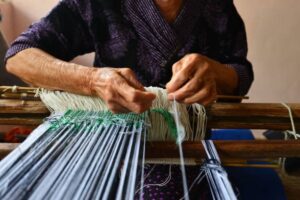Baling yarn is a process that takes fibres and compresses them to a recognisable size. It is used for knitting, crocheting and other crafts.
The fibres are usually packaged in bundles, called skeins, which are sold to hobbyists and knitters. Another type of bundle, a hank, is used for more significant production.
Agricultural Yarn
Agricultural yarn is made from natural fibres such as cotton, wool, alpaca, angora, and mohair. These fibres are raised in livestock programs explicitly designed to produce textile fibres.
 Often, the fibres are harvested from sheep, goats, llamas, and alpacas. A textile mill then processes the harvest to produce yarn. The yarn is used for knitting and weaving or in other crafts such as crocheting, braiding, felting, and webbing.
Often, the fibres are harvested from sheep, goats, llamas, and alpacas. A textile mill then processes the harvest to produce yarn. The yarn is used for knitting and weaving or in other crafts such as crocheting, braiding, felting, and webbing.
Step One: The cotton is harvested and ginned (separating the cotton seeds from the cotton fibres). It is shipped in bales for yarn manufacturing.
The cotton is then subjected to mechanical operations, including opening and cleaning, picking, carding, combing, drawing, roving, and spinning. The resulting fibres are finer and smoother than cotton chaff. Depending on the mechanical formation method, the finished product can be turned to produce a worsted or woollen yarn. Some secondary processes are also necessary, such as a steam explosion or matting.
Artisan Yarn
Artisan yarn is typically a combination of plant and animal fibres spun to create a unique texture. It can be used to make various items, from hats and scarves to socks and blankets.
The most important feature to consider when selecting a yarn is its weight. Tales vary in WPI (Wraps Per Inch), a standard measure of yarn strength, and are generally divided into four categories: fine, medium, bulky, and super bulky.
One of the best artisan yarns is MSY, a beautiful blend of 60% Superwash Merino wool for softness, 20% Silk for lustre, and 20% Yak for durability and stretch. It has a halo-like sheen and drape and is available in various colours inspired by beautiful Irish landscapes. The colourways are hand dyed in small batches and may differ slightly from skein to skein, making them the perfect choice for a unique knitted item! It is also machine washable at 30 degrees.
Fine Yarn
Cotton is the most commonly spun plant fibre and a knitting industry staple. It is a breathable, versatile and soft fibre that is popular for a variety of different types of knits.
Fine yarn is a type of yarn that is made from fine plant fibres like cotton. These yarns are typically lightweight and can make socks, wraps and baby items.
Check the label for the weight and suggested gauge when looking for fine yarn. You can also find care instructions and suggestions on these labels for keeping your finished project in good condition.
Several units are in use to describe the linear density of a roving of fibres, such as tex and denier. The two teams are similar, but tex is more common in Canada and Continental Europe, while denier is more commonly used in the United States. Yield is another unit that is often used in the textile industry.
Commercial Yarn
Commercial yarn is spun from various fibrous materials and converted into uniform, easy-to-use strands. The process is called yarn spinning and has been completed by hand for centuries.
Several steps are involved in creating the final product, including twisting, carding, and winding. In addition, the yarn that is made from each step must be accurately weighed to ensure consistency in the finished product.
Several counting systems are used to determine the weight of the yarn, such as the Tex system (used for cotton and silk), denier, and jute. The Tex system is the most widely used, using the length of a hank to determine the weight in grams.
When making yarns for hand-knitting, you must know what type of ply you’re using and how much twist it has. The number of twists in the ply will affect the yarn’s behaviour, strength, and elasticity and how it relates to pattern stitch definition.
Baling Yarn
Baling yarn is a process of bringing yarn to a specific size by pressure. It is done to facilitate transport within the country and for export abroad.
Cotton is the most common fibre spun into fine yarn for mechanical weaving or knitting into cloth. It is a breathable and versatile fibre.
The Basics of Baling Yarn
Baling yarn compresses cotton yarn to a smaller size to be quickly loaded in a container or truck. It is an integral part of the textile industry.
